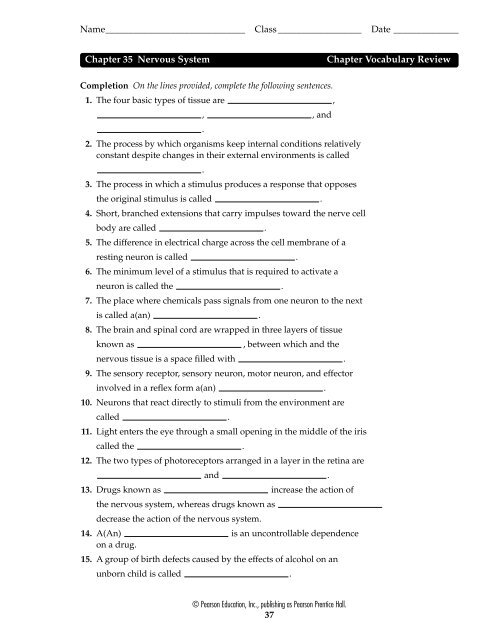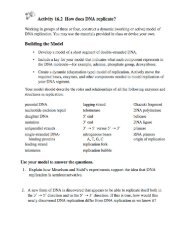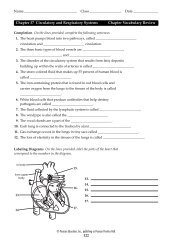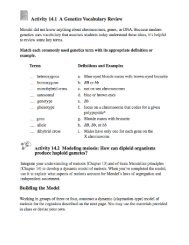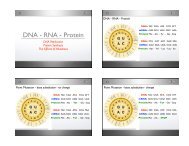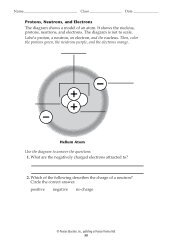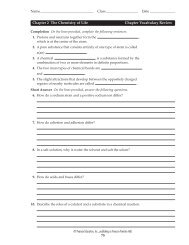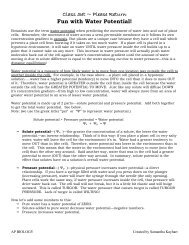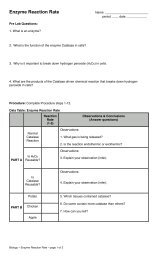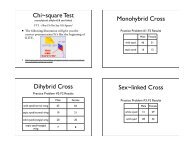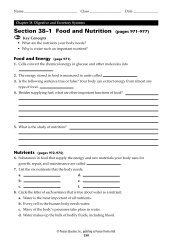Chapter 35 Nervous System Chapter Vocabulary Review
Chapter 35 Nervous System Chapter Vocabulary Review
Chapter 35 Nervous System Chapter Vocabulary Review
- No tags were found...
Create successful ePaper yourself
Turn your PDF publications into a flip-book with our unique Google optimized e-Paper software.
Name______________________________ Class __________________ Date ______________<br />
<strong>Chapter</strong> <strong>35</strong> <strong>Nervous</strong> <strong>System</strong><br />
<strong>Chapter</strong> <strong>Vocabulary</strong> <strong>Review</strong><br />
Completion On the lines provided, complete the following sentences.<br />
1. The four basic types of tissue are ,<br />
, , and<br />
.<br />
2. The process by which organisms keep internal conditions relatively<br />
constant despite changes in their external environments is called<br />
.<br />
3. The process in which a stimulus produces a response that opposes<br />
the original stimulus is called .<br />
4. Short, branched extensions that carry impulses toward the nerve cell<br />
body are called .<br />
5. The difference in electrical charge across the cell membrane of a<br />
resting neuron is called .<br />
6. The minimum level of a stimulus that is required to activate a<br />
neuron is called the .<br />
7. The place where chemicals pass signals from one neuron to the next<br />
is called a(an) .<br />
8. The brain and spinal cord are wrapped in three layers of tissue<br />
known as<br />
, between which and the<br />
nervous tissue is a space filled with .<br />
9. The sensory receptor, sensory neuron, motor neuron, and effector<br />
involved in a reflex form a(an) .<br />
10. Neurons that react directly to stimuli from the environment are<br />
called .<br />
11. Light enters the eye through a small opening in the middle of the iris<br />
called the .<br />
12. The two types of photoreceptors arranged in a layer in the retina are<br />
and .<br />
13. Drugs known as increase the action of<br />
the nervous system, whereas drugs known as<br />
decrease the action of the nervous system.<br />
14. A(An) is an uncontrollable dependence<br />
on a drug.<br />
15. A group of birth defects caused by the effects of alcohol on an<br />
unborn child is called .<br />
© Pearson Education, Inc., publishing as Pearson Prentice Hall.<br />
37
Name______________________________ Class __________________ Date ______________<br />
Labeling Diagrams On the lines provided, label the areas of the brain.<br />
21.<br />
16.<br />
16.<br />
17.<br />
18.<br />
20.<br />
19.<br />
18.<br />
17.<br />
19.<br />
20.<br />
21.<br />
Multiple Choice On the line provided, write the letter of the answer that best<br />
completes each sentence or answers the question.<br />
22. A cell that carries messages through the nervous<br />
system is called a<br />
a. rod. c. cone.<br />
b. dendrite. d. neuron.<br />
23. A quick, automatic response to a stimulus is a<br />
a. reflex. c. reflex arc.<br />
b. stimulant. d. neuron.<br />
24. What part of your eye uses small muscles to change<br />
its shape so that you can focus on near or distant<br />
objects<br />
a. retina c. cornea<br />
b. lens d. pupil<br />
25. The cochlea and semicircular canals can be found in<br />
the<br />
a. inner ears. c. taste buds.<br />
b. eyes. d. sensory receptors.<br />
© Pearson Education, Inc., publishing as Pearson Prentice Hall.<br />
38


